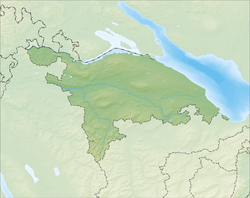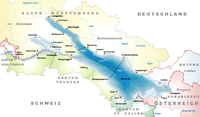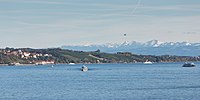Altnau
Altnau | |
|---|---|
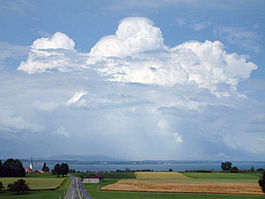 | |
| Coordinates:47°37′N9°15′E/ 47.617°N 9.250°E | |
| Country | Switzerland |
| Canton | Thurgau |
| District | Kreuzlingen |
| Area | |
| • Total | 6.67 km2(2.58 sq mi) |
| Elevation | 471 m (1,545 ft) |
| Population (31 December 2018)[2] | |
| • Total | 2,244 |
| • Density | 340/km2(870/sq mi) |
| Time zone | UTC+01:00(Central European Time) |
| • Summer (DST) | UTC+02:00(Central European Summer Time) |
| Postal code(s) | 8595 |
| SFOS number | 4641 |
| ISO 3166 code | CH-TG |
| Surrounded by | Güttingen,Hagnau am Bodensee(DE-BW),Langrickenbach,Münsterlingen,Stetten(DE-BW) |
| Website | www SFSO statistics |
Altnauis amunicipalityin the district ofKreuzlingenin thecantonofThurgauinSwitzerland.
History
[edit]Near thehamletof Ruderbaum, the remains of aHorgen culturesettlement have been discovered. Below the Horgen site, there also may be aPfyn culturesite, but that is less certain.
The modern village of Altnau may be first mentioned in 787 asAlthinouva.[3]In the 8th Century theAbbey of St. Gallowned most of the land in Altnau. In 1155, EmperorFriedrich Barbarossaconfirmed that the Cathedral ofConstanceowned the church and church yard in the village. Thevogtright over the church's farms belonged to theFreiherrof Altenklingen after 1300. During theLate Middle Ages,this right was given to several noble families from Constance; 1378 Schwarz, 1430 Tettikofen, 1468 Mangolte, and from 1471 until 1798 the city of Constance directly controlled the farms. In 1454 the villagers were represented in theAppenzellLandrecht,but following complaints from Constance they were forced to give up their membership. The rights of the village are first listed in theGerichtsoffnungof 1468.[3]

The right to administer theparishof Altnau went from the cathedral'sprovostto the cathedral'sdeanin 1347. After theProtestant Reformationin 1528, the few remaining Catholics were looked after by Constance and the village church became ashared church.This situation remained until 1810 when two churches were completed.
Until the 19th Century, most of the local economy revolved aroundthree-fieldagriculture. About 1880 a dairy company was founded in the village, and livestock and cheese production became common.Viticulturewas common from theMiddle Agesuntil 1912. In 1840 theSeestrasse(Lake Road) was built, and in 1870, theSeetalbahn(railroad line) was added. However, neither the road or the railroad led to a boost in the local economy, as the station was too far away.[3]
Geography
[edit]Altnau has an area, as of 2009[update],of 6.68 square kilometers (2.58 sq mi). Of this area, 4.72 km2(1.82 sq mi) or 70.7% is used for agricultural purposes, while 1.03 km2(0.40 sq mi) or 15.4% is forested. Of the rest of the land, 0.93 km2(0.36 sq mi) or 13.9% is settled (buildings or roads), 0.02 km2(4.9 acres) or 0.3% is either rivers or lakes.[4]
Of the built up area, industrial buildings made up 7.0% of the total area while housing and buildings made up 0.6% and transportation infrastructure made up 0.7%. Power and water infrastructure as well as other special developed areas made up 1.6% of the area while parks, green belts and sports fields made up 3.9%. Out of the forested land, all of the forested land area is covered with heavy forests. Of the agricultural land, 47.2% is used for growing crops, while 23.5% is used for orchards or vine crops. All the water in the municipality is flowing water.[4]
The municipality is located in the Kreuzlingen district along theRomanshorn-Kreuzlingenroad about 2 km (1.2 mi) fromLake Constance.
Demographics
[edit]Altnau has a population (as of December 2020[update]) of 2,343.[5]As of 2008[update],15.5% of the population are foreign nationals.[6]Over the last 10 years (1997–2007) the population has changed at a rate of 11.8%. Most of the population (as of 2000[update]) speaksGerman(94.5%), withAlbanianbeing second most common ( 1.1%) andItalianbeing third ( 0.9%).[7]
As of 2008[update],the gender distribution of the population was 51.2% male and 48.8% female. The population was made up of 829 Swiss men (42.5% of the population), and 170 (8.7%) non-Swiss men. There were 819 Swiss women (42.0%), and 133 (6.8%) non-Swiss women.[6]
In 2008[update]there were 17 live births to Swiss citizens and 4 births to non-Swiss citizens, and in same time span there were 8 deaths of Swiss citizens. Ignoring immigration and emigration, the population of Swiss citizens increased by 9 while the foreign population increased by 4. There was 1 Swiss man, 1 Swiss woman who emigrated from Switzerland to another country, 10 non-Swiss men who emigrated from Switzerland to another country and 12 non-Swiss women who emigrated from Switzerland to another country. The total Swiss population change in 2008 (from all sources) was an increase of 57 and the non-Swiss population change was an increase of 13 people. This represents apopulation growth rateof 3.7%.[6]
The age distribution, as of 2009[update],in Altnau is; 199 children or 10.0% of the population are between 0 and 9 years old and 295 teenagers or 14.9% are between 10 and 19. Of the adult population, 193 people or 9.7% of the population are between 20 and 29 years old. 247 people or 12.5% are between 30 and 39, 395 people or 19.9% are between 40 and 49, and 277 people or 14.0% are between 50 and 59. The senior population distribution is 222 people or 11.2% of the population are between 60 and 69 years old, 104 people or 5.2% are between 70 and 79, there are 45 people or 2.3% who are between 80 and 89, and there are 4 people or 0.2% who are 90 and older.[8]
As of 2000[update],there were 679 private households in the municipality, and an average of 2.6 persons per household.[7]In 2000[update]there were 351 single family homes (or 84.0% of the total) out of a total of 418 inhabited buildings. There were 32 two family buildings (7.7%), 11 three family buildings (2.6%) and 24 multi-family buildings (or 5.7%).[9]There were 384 (or 21.3%) persons who were part of a couple without children, and 1,101 (or 61.0%) who were part of a couple with children. There were 108 (or 6.0%) people who lived in single parent home, while there are 6 persons who were adult children living with one or both parents, 6 persons who lived in a household made up of relatives, 26 who lived in a household made up of unrelated persons, and 9 who are either institutionalized or live in another type of collective housing.[10]
The vacancy rate for the municipality, in 2008[update],was 0.73%. As of 2007[update],the construction rate of new housing units was 3.7 new units per 1000 residents.[7]In 2000[update]there were 751 apartments in the municipality. The most common apartment size was the 5 room apartment of which there were 202. There were 16 single room apartments and 183 apartments with six or more rooms.[11]As of 2000[update]the average price to rent an average apartment in Altnau was 1109.58Swiss francs(CHF) per month (US$890, £500, €710 approx. exchange rate from 2000). The average rate for a one-room apartment was 466.43 CHF (US$370, £210, €300), a two-room apartment was about 728.08 CHF (US$580, £330, €470), a three-room apartment was about 787.67 CHF (US$630, £350, €500) and a six or more room apartment cost an average of 1543.68 CHF (US$1230, £690, €990). The average apartment price in Altnau was 99.4% of the national average of 1116 CHF.[12]
In the2007 federal electionthe most popular party was theSVPwhich received 38.69% of the vote. The next three most popular parties were theGreen Party(17.58%), theFDP(14.91%) and theCVP(11.74%). In the federal election, a total of 560 votes were cast, and thevoter turnoutwas 45.6%.[13]
The historical population is given in the following table:[3][14]
| year | population |
|---|---|
| 1850 | 869 |
| 1910 | 1,001 |
| 1970 | 957 |
| 1980 | 1,036 |
| 1990 | 1,439 |
| 2000 | 1,804 |
Sights
[edit]The entire village of Altnau is designated as part of theInventory of Swiss Heritage Sites.[15]
Economy
[edit]As of 2007[update],Altnau had an unemployment rate of 1.46%. As of 2005[update],there were 100 people employed in theprimary economic sectorand about 32 businesses involved in this sector. 187 people are employed in thesecondary sectorand there are 35 businesses in this sector. 317 people are employed in thetertiary sector,with 66 businesses in this sector.[7]
In 2000[update]there were 1,311 workers who lived in the municipality. Of these, 632 or about 48.2% of the residents worked outside Altnau while 192 people commuted into the municipality for work. There were a total of 871 jobs (of at least 6 hours per week) in the municipality.[16]Of the working population, 9.9% used public transportation to get to work, and 49.1% used a private car.[7]
Religion
[edit]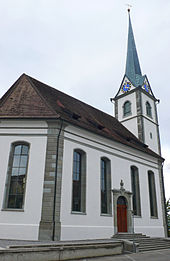
From the 2000 census[update],570 or 31.6% wereRoman Catholic,while 881 or 48.8% belonged to theSwiss Reformed Church.Of the rest of the population, there are 5 individuals (or about 0.28% of the population) who belong to the Orthodox Church, and there are 74 individuals (or about 4.10% of the population) who belong to another Christian church. There were 43 (or about 2.38% of the population) who areIslamic.There are 4 individuals (or about 0.22% of the population) who belong to another church (not listed on the census), 169 (or about 9.37% of the population) belong to no church, areagnosticoratheist,and 58 individuals (or about 3.22% of the population) did not answer the question.[17]
Transport
[edit]Altnau sits on theLake LinebetweenSchaffhausenandRorschachand is served by theSt. Gallen S-BahnatAltnau railway station.
Education
[edit]In Altnau about 79.2% of the population (between age 25-64) have completed either non-mandatoryupper secondary educationor additional higher education (either university or aFachhochschule).[7]
Altnau is home to the Altnauprimary school district.It is also home to the Altnau secondary school district. In the 2008/2009 school year there were 176 students in the primary school district. There were 44 children in thekindergarten,and the average class size was 22 kindergartners. Of the children in kindergarten, 18 or 40.9% were female, 7 or 15.9% were not Swiss citizens and 2 or 4.5% did not speak German natively. The lower and upper primary levels begin at about age 5-6 and last for 6 years. There were 59 children in who were at the lower primary level and 73 children in the upper primary level. The average class size in the primary school was 22 students. At the lower primary level, there were 26 children or 44.1% of the total population who were female, 5 or 8.5% were not Swiss citizens and 1 or 1.7% did not speak German natively. In the upper primary level, there were 35 or 47.9% who were female, 6 or 8.2% were not Swiss citizens and 3 or 4.1% did not speak German natively.
There are 273 students in the secondary school district. At the secondary level, students are divided according to performance. The secondary level begins at about age 12 and usually lasts 3 years. There were 178 teenagers who were in the advanced school, of which 97 or 54.5% were female, 15 or 8.4% were not Swiss citizens and 7 or 3.9% did not speak German natively. There were 95 teenagers who were in the standard school, of which 47 or 49.5% were female, 23 or 24.2% were not Swiss citizens and 18 or 18.9% did not speak German natively. The average class size for all classes at the secondary level was 18.2 students.[18]
References
[edit]- ^ab"Arealstatistik Standard - Gemeinden nach 4 Hauptbereichen".Federal Statistical Office.Retrieved13 January2019.
- ^"Ständige Wohnbevölkerung nach Staatsangehörigkeitskategorie Geschlecht und Gemeinde; Provisorische Jahresergebnisse; 2018".Federal Statistical Office. 9 April 2019.Retrieved11 April2019.
- ^abcdAltnauinGerman,FrenchandItalianin the onlineHistorical Dictionary of Switzerland.
- ^abSwiss Federal Statistical Office-Land Use Statistics2009 data(in German)accessed 25 March 2010
- ^"Ständige und nichtständige Wohnbevölkerung nach institutionellen Gliederungen, Geburtsort und Staatsangehörigkeit".bfs.admin.ch(in German). Swiss Federal Statistical Office - STAT-TAB. 31 December 2020.Retrieved21 September2021.
- ^abcSwiss Federal Statistical Office - Superweb database - Gemeinde Statistics 1981-2008ArchivedJune 28, 2010, at theWayback Machine(in German)accessed 19 June 2010
- ^abcdefSwiss Federal Statistical OfficeArchivedJanuary 5, 2016, at theWayback Machineaccessed 20-September-2010
- ^Statistical Office of ThurgauArchivedFebruary 5, 2010, at theWayback Machine,MS Excel document –Altersstruktur der Wohnbevölkerung nach zivilrechtlichem Wohnsitzbegriff am 31.12.2009(in German)accessed 23 June 2010
- ^Statistical Office of ThurgauArchivedApril 20, 2010, at theWayback Machine,MS Excel document -Wohngebäude nach Anzahl Wohneinheiten und Gemeinden, Jahr 2000(in German)accessed 24 June 2010
- ^Statistical Office of ThurgauArchivedDecember 30, 2009, at theWayback Machine,MS Excel document –Wohnbevölkerung nach Haushaltstyp und Gemeinde, Jahr 2000(in German)accessed 23 June 2010
- ^Statistical Office of ThurgauArchivedApril 20, 2010, at theWayback Machine,MS Excel document -Wohnungen nach Anzahl Zimmer und Gemeinden, Jahr 2000(in German)accessed 24 June 2010
- ^Statistical Office of ThurgauArchivedMay 7, 2010, at theWayback Machine,MS Excel document -Durchschnittlicher Wohnungsmietpreis nach Anzahl Zimmer und Gemeinden(in German)accessed 24 June 2010
- ^Swiss Federal Statistical Office,Nationalratswahlen 2007: Stärke der Parteien und Wahlbeteiligung, nach Gemeinden/Bezirk/CantonArchivedMay 14, 2015, at theWayback Machine(in German)accessed 28 May 2010
- ^Statistical Office of ThurgauArchivedApril 14, 2010, at theWayback Machine,MS Excel document –Wohnbevölkerung im Kanton Thurgau nach Gemeinden, seit 1850(in German)accessed 22 June 2010
- ^"Kantonsliste A-Objekte: Thurgau"(PDF).KGS Inventar(in German). Federal Office of Civil Protection. 2009. Archived fromthe original(PDF)on 18 July 2011.Retrieved28 November2009.
- ^Swiss Federal Statistical Office - Statweb(in German)accessed 24 June 2010
- ^Statistical Office of ThurgauArchivedApril 18, 2010, at theWayback Machine,MS Excel document –Wohnbevölkerung Gemeinden nach religiöser Zugehörigkeit, Jahr 2000(in German)accessed 23 June 2010
- ^Canton Thurgau SchoolsArchived2011-07-07 at theWayback Machine(in German)accessed 23 June 2010
External links
[edit]- AltnauinGerman,FrenchandItalianin the onlineHistorical Dictionary of Switzerland.





